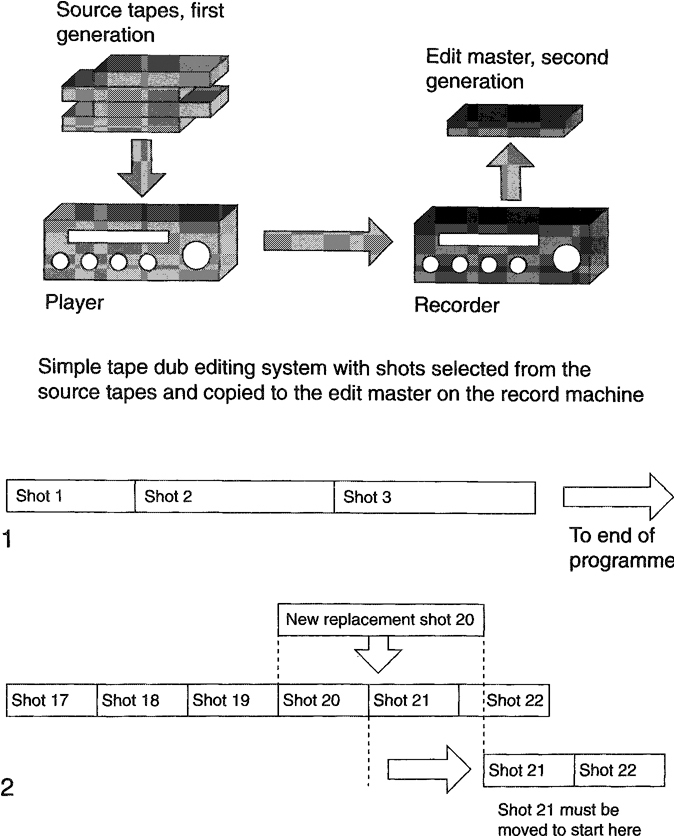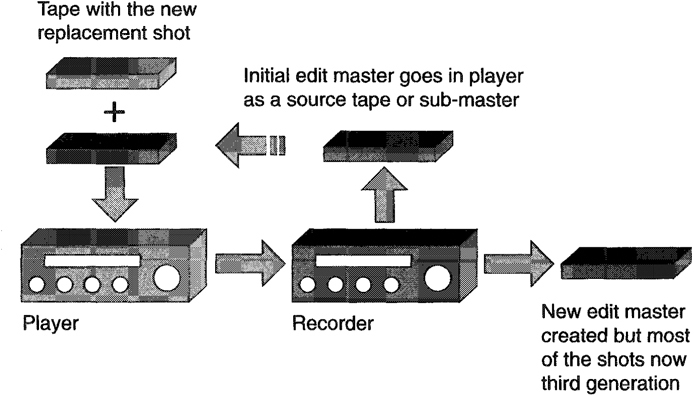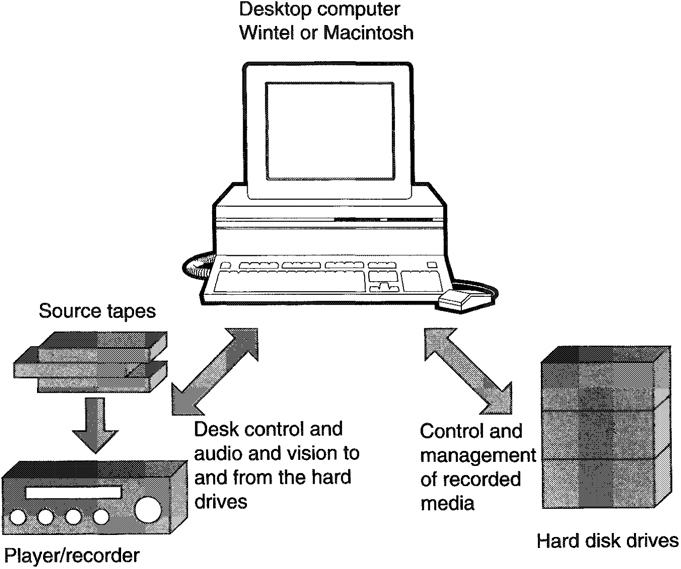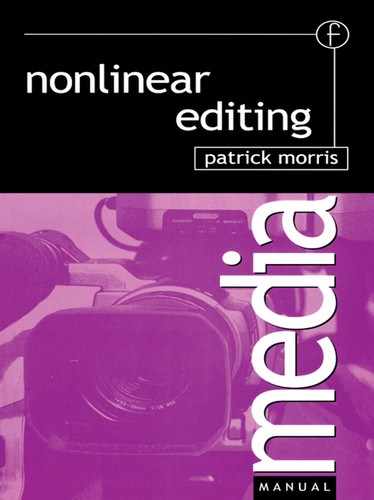Chapter 1
What is linear editing?
Before considering nonlinear editing, it is necessary to define what linear editing is. Linear editing is usually used to describe videotape editing. The term linear editing arrived after the advent of computerized nonlinear editing and, while the designation may well have originated from some sales pitch, it has stuck and is in many ways an appropriate term.
Linear videotape editing is the copy or dub editing process where shots are selected and copied from the source tape to the record or edit tape. The term linear highlights the straight-line principle of editing on tape, where typically an editor will start with shot one of a sequence and then add shot two, then shot three and so on until the programme is complete. What must be remembered is that tape-to-tape editing is a real-time process, which means that a 10-second shot will take 10 seconds to copy from the source tape to the record tape. In fact the actual process is longer than real time when one adds pre- and post-roll times.
This in itself is fine, but problems start to arise when changes are made. For example, suppose there is a 50 shot sequence and the decision is made to replace shot 20 with a new longer shot, but at the same time shots 21 to the end of the sequence are to remain the same length.
There are solutions, but the two most common do impose penalties. One approach is to take the whole programme down a generation and at the appropriate point add in the new material, then continue with the rest of the programme. In effect the original programme becomes a source tape, known as a sub-master. This process unfortunately takes time and results in loss of quality especially when using analogue tape – although with digital tape multi-generation losses are not so much of a problem. The second solution is to add in the new shot at the appropriate point on the original record tape and then re-edit all subsequent shots to complete the programme. This process preserves quality but imposes a major time penalty.
The limitations of tape

(l) Shots edited in a straight-line process.
(2) Making changes to a videotape edit can be time consuming and impose quality penalties.
What’s good?
• For just a few shots, tape-to-tape ‘cuts’ only editing can be very quick.
What’s bad?
• As editing requirements go beyond cuts only, tape-to-tape editing can get expensive.
• If you change your mind then time and quality penalties will beimposed.
Using sub-masters

Using sub-masters saves time, but in an analogue environment can lead to picture degradation.
What is nonlinear editing?
In some ways nonlinear editing is similar to linear editing. The common area is that source material (rushes) must be copied from tape to a new recording medium. The difference is that the new recording medium is a hard disk drive. During this process the off-tape video is converted to a digital format and recorded onto a hard disk drive. In effect the video is edited to the hard disk drive. The hard disk drives are usually external to the computer platform with sizes ranging from 2 GB to 23 GB. It is possible to daisy-chain a number of drives together to increase storage capacity. We shall see later that it is these hard drives that are one of the major limitations of nonlinear systems because you cannot have unlimited storage. This means nonlinear systems are not usually suitable for archive purposes. Wherever possible a programme will be loaded in, edited, downloaded for transmission and then the digitized programme material removed from the hard disk drives.
From here all similarities cease to exist. With all the rushes on the hard disk drives, an editor working on a nonlinear system enjoys the same increased flexibility that a typist does when changing from a typewriter to a computerized word processor. Just as one can copy and paste, duplicate, and move text around in a word processor, so one can manoeuvre sound and vision in a nonlinear editing system.
This cut and paste environment offers tremendous flexibility and speed. At the click of a button a shot can be replaced, lengthened or shortened at any time. Another advantage that these hard disk-based editing systems offer is access to multiple audio and video tracks and sophisticated editing tools. Editors transferring to this new technology may initially be apprehensive but invariably reach a point where they never want to see tape again.
When comparing linear and nonlinear, cost is also a factor. A typical linear videotape edit suite capable of performing simple effects, in addition to basic cuts, requires at least three videotape machines (i.e. two playback machines and a recorder). The installation also needs vision and sound mixing desks and an edit controller. The nonlinear system requires only one player/recorder and the editing system (usually a desktop computer). Overall the nonlinear system is cheaper to both purchase and run.
A basic nonlinear editing system

Usually the installation will include two computer monitors, audio monitoring and sound mixing and a video monitor.
What’s good?
• it is fast and flexible.
• It involves lower cost.
What’s hart?
• There is a new and sometimes steep learning curve.
• Storage is a limitation and needs to be carefully managed.
A nonlinear editing system

Professional systems offer two computer monitors – screen real estate is often at a premium. For quick access to all source material a dedicated monitor is recommended as a resource monitor. The video monitor provides real-time monitoring for quality control. In addition, video waveform monitors and vectorscopes will be installed
